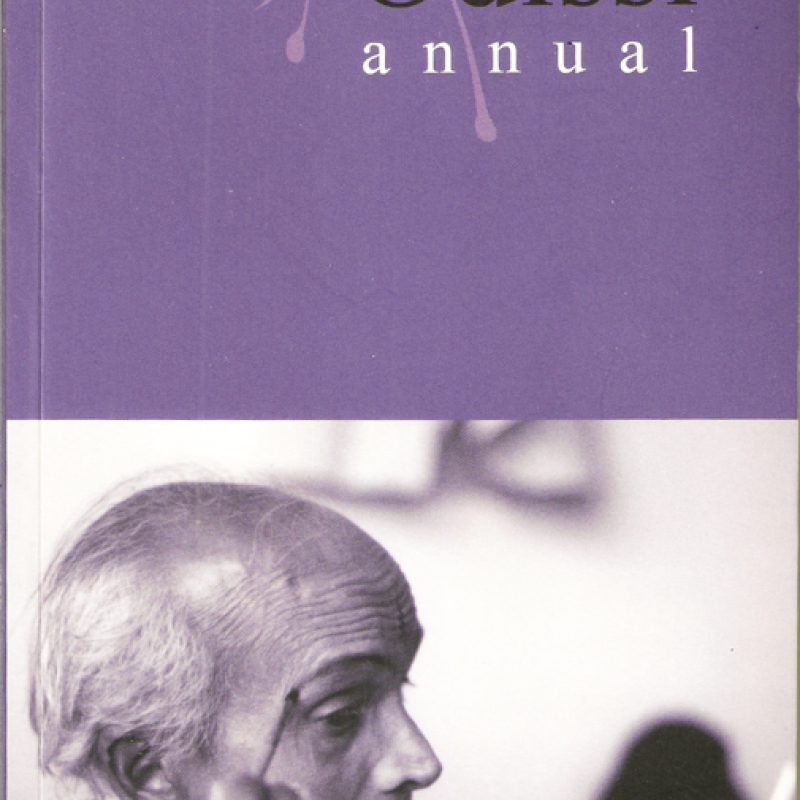Guru Pankaj Charan Das is the fountainhead of Odissi or Orissi, as it was previously known. He was born on March 17, 1921 (or 1925 as per family accounts) into a large joint family that had no sons and therefore was considered accursed. His mother, Kshetramani, was carrying him when she went on an extended visit to Puri, to offer prayers to Lord Jagannath. She stayed with a mahari[1], a family friend, and the child was born prematurely. Fearing that the curse might harm the boy if he were brought into the family, she decided to leave him with the mahari, who willingly agreed to be his foster mother. She was Chintamani.
Pankaj Charan Das thus grew up in a setting of song and dance. Chintamani was an accomplished dancer and singer; her home was the meeting place of many who shared these interests. Also, there was an akhada[2] in front of the house which resounded all day long with akadha pillas (pupils of the akhada) and, naturally, Pankaj as a boy was exposed to this. He went to school but minimally. He loved attending performances of the touring dance drama companies that offered the jatra[3] and Ras Leela[4]. From seven years of age, Pankaj himself started appearing in song and dance amateur presentations. In the Ras Leela, he even received a sort of training from the dance teachers appointed for this purpose.
Pankaj was six when his father Dharmacharana Das died. From then on, his mother came to live with him and Chintamani. As he grew up, he began to feel a sense of responsibility towards them. His casual excursions into the world of drama brought him some money occasionally but was hardly enough for the three of them. At 12, he got his first steady job as supplier and seller of paan and tobacco. He was to serve inside a cinema hall, and received a commission of an anna (25 paise) in a rupee. What fascinated him was the regular song and dance on the screen, which he loved to imitate to amuse his friends.
When he was 16, his mother died. The Second World War had begun and life was difficult, with shortages, blackout and restricted entertainment. Pankaj worked in an office, on a salary of Rs. 8 per month, and there he continued for two years. At work, one day, he saw an announcement in a paper that a new theatre company had started in Cuttack that required artistes. This was in New Theatres, a pioneering theatre group in Orissa that surfaced in the 1940s. That night, he left for Cuttack and was appointed upon arrival. He was promised no salary, however, food and clothing were provided. He had to do small song and dance acts in the plays, mostly duets in which his principal partner was a young girl named Yashoda.
New Theatres did not last long, and after it broke up in 1944, Pankaj Charan returned to Puri. He now got a part in a leading Ras Leela party, where he had to act in comic roles apart from singing and dancing as well. In fact, he along with two others, Tima and Pande, were the most popular comic turn on the Orissa stage. In this Raas party, Pankaj Charan Das met Kelucharan, an actor. About the same time, another pioneering theatre group, Orissa Theatres, founded by one of Orissa’s leading poet-dramatists, Kali Charan Patnaik, broke up and some of the artistes got together to form another group that they called Annapurna “B”. Like Orissa Theatres Group, this too was in Cuttack. It was labeled “B” to distinguish from the Annapurna “A” group in Puri. Pankaj Charan Das joined Annapurna B almost as soon as it was formed. He was appointed as an actor, on Rs. 8 per month and food. When it was realised that he could dance as well and compose dances, he was given the status of Dance Director, and his salary was raised to an impressive Rs. 10, with pocket allowance of 4 annas on the day of performance, which were practically throughout the month. On one of the company’s tours in Puri, Pankaj Charan met Kelucharan again and invited him to join Annapurna B, which he did promptly.
Many years later, two others were to join this group—Deba Prasad Das and Mayadhar Raut. All four together—Pankaj Charan Das, Kelucharan Mahapatra, Deba Prasad Das and Mayadhar Raut—made what Odissi is today. They were supported by historical forces and people but they alone can be counted as the pillars of the dance form, with Pankaj Charan Das being the fountainhead.
Around the middle of the 1940s, the embryonic name Oriya Nacho was replaced with Orissi. Actually, the term ‘Orissi’ had been first used in 1945 for a music broadcast of the Odihstate at All India Radio, Calcutta. In Orissa, the term conveniently got extended to dance. Whilst music was labeled Orissi Sangeet, for dance just Orissi was considered good enough. In the early 1960s, the spelling quite unimaginatively got altered to Orissi with a ‘d’, i.e. Odissi, and it has since been known thus.
In 1948, Pankaj left Annapurna B, followed by the entry of Dayal Sharan, one-time member of Uday Shankar’s troupe. He, however, did not join Annapurna as a regular. A year later, Kelucharan too left Annapurna B. Deba Prasad left in 1951 and Mayadhar Raut in 1953.
The theatre movement in Orissa was then gaining strength and drama companies mushroomed, particularly in Cuttack. In dance, all of them followed the pattern set earlier, which means they either wove dance into the theme of the play by improvising a situation where none existed or prefaced the play with a composition. All four had gained considerable experience by now and were much in demand by these companies. Some of them continued to work together, as in the Rupasree and Janta drama companies, but largely handled casual assignments. And it is during this period that, for the first and only time in their long careers, all four had the opportunity to appear together on stage. This was in 1953, on the occasion of Bhanja Jayanti, an annual celebration in Cuttack in honour of Upendra Bhanja that continues to date. On the occasion, Sita Harana, a ballet of sorts on Sita’s abduction by Ravana, was presented with Kelucharan appearing as Rama, Laxmipriya as Sita, Mayadhar Raut as Lakshmana, Deba Prasad as Ravana and Pankaj Charan as the mythical bird Jatayu.
Till 1953, there was no such thing as an independent dance performance in Orissa. Theatre dance had no independent status or identity but existed as supplement to drama. Every dancer/choreographer had a particular style and vision. Interestingly, however, what developed over time in the dance styles of the four pioneers of Odissi dance was a harmonious entity, meaning no matter who composed the dance it carried a common form, an identifiable character. This emerging style did reveal the early influences on the dance form—the mahari tradition Pankaj Charan Das was exposed to, the Raas Leela tradition of Kelucharan, the akhada tradition of Deba Prasad and emerging theatre trends to which Mayadhar was exposed—that appeared as a whole, collectively. Theatre connected them all. Props, so common in theatre and not in classical dance, were used freely in this new style!
In the year 1952, there was another development. To all appearances it was a small step but one that proved to be of great consequence. This was the founding of the institution Kala Vikash Kendra at Cuttack. Strangely, KVK owes its genesis wholly to the initiative of a Gujarati settled in Orissa—Babulal Doshi, whose colleague and support was dancer and scholar Dhirendranath Patnaik.
By 1954, dance had become accepted in polite society which had previously shunned gotipuas[5], maharis and akhada traditions. When Utkal Sangeet Mahavidyalaya was established in Bhubaneswar in early 1960s, Guru Pankaj Charan Das joined as Senior Faculty Guru. He choreographed many pallavis, including the intricate Gativilas, set to music by doyen Harihar Panda and Balakrushna Das. He created for male dancers a special piece, Om Namaha Shivaya, and for representing women his everlasting work is the Panchkanyas. The lasya, the thani of Odissi and its essence comes through in Guru Pankaj Charan Das’s work. He died on June 11, 2003.
His star students include names such as Yamini Krishnamurthy, Ritha Devi and so on. Yamini is credited to have taken Guru Pankaj Charan Das to Bombay, where Ritha Devi first saw him and wanted to learn the dance form from the master himself. Ritha Devi later also told Indrani about this new style. Indrani quickly left all and went to Orissa to learn the style of Deba Prasad and the rest is history. While Yamini was the pioneer outside of Orissa to have taken to Odissi, it was Indrani who danced at a momentous occasion in Delhi and made Odissi her own. Post Indrani’s becoming Miss India in 1952 and her dance performance in 1958 in Delhi, she made national news and came to be most identified with the style when it first got established and soon Odissi was born nationally. Ritha Devi, among others, including Pankaj Charan Das’s own daughter, and later students like Ratna Roy did much to propagate the form.
Endnotes
[1]Maharis were the temple dancers akin to devadasis of South India. There were broadly two types of maharis—Bheetar gauni and Bahar gauni (inside sanctum sanctorum and outside, respectively). These dances were a ceremonial part of daily temple rituals and had a place of eminence in society which declined when corrupt practices set in.
[2] Akhadas are wrestling clubs or gymnasiums for boys where physical exercises, which are combative in nature, are taught. In Orrisa, however, akhadas were also centres for training in dance. In villages in Orissa, it was common practice to send young boys to these akhadas for early training.
[3] Jatra is a traditional itinerant theatre of eastern belt of India, which delivers social and political messages for the masses through theatrical performance.
[4] Ras Leela is a form of devotional dance centered around the Krishna cult involving his beloved Radha or sakhis/gopis of Radha. It is prevalent and popular in belts where Krishna lore is predominant.
[5] Gotipua, literally menaing ‘single boy’ in Odia, is a dance form said to be the precursor of the Odissi classical dance and is named thus because it is performed mainly by young pre-pubertal boys dressed as girls, called gotipuas.













